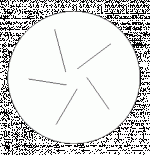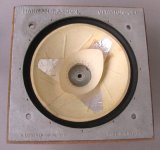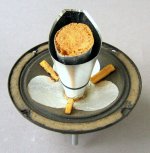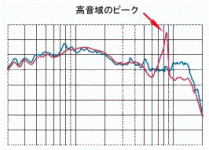Hi Oliver,
I like your rear mufflers. Something I shall keep in mind.
Hi graaf,
The foam fingers work alright.
In the photo I have the lower finger dispersing some hf at the dustcap. The upper finger additionally improves overall reproduction.
Dual cone drivers might benefit with a pair of separate shallow horizontal fingers modifying the horizontal radiation pattern by reducing off-axis cancellation.
Cheers ........ Graham.
I like your rear mufflers. Something I shall keep in mind.
Hi graaf,
The foam fingers work alright.
In the photo I have the lower finger dispersing some hf at the dustcap. The upper finger additionally improves overall reproduction.
Dual cone drivers might benefit with a pair of separate shallow horizontal fingers modifying the horizontal radiation pattern by reducing off-axis cancellation.
Cheers ........ Graham.
graaf said:
very interesting!
does it work (is it needed?) also if one listens extremely off axis?
(my Fostexes work in a Carlsson type omnidirectional setup)
are there any measurements showing how the rollers work?
best,
graaf
Concerning the foam pieces:
Due to my experience, it is always worthwile to experiment
with Grahams ideas ... 🙂
Cheers
Graham Maynard said:Hi Oliver,
I like your rear mufflers. ...
I would prefer the term "muffling device" ... 😀
( Word sounds funny to my german ears
"müffeln" (slang) = to smell badly ...)
Cheers
Hi Oliver,
That descrition came as a surprise.
http://www.thefreedictionary.com/muffler
Yes we always need to be careful in case we say something different to what intended.
A product named thus might not sell well in your country.
Cheers .... Graham.
That descrition came as a surprise.
http://www.thefreedictionary.com/muffler
Yes we always need to be careful in case we say something different to what intended.
A product named thus might not sell well in your country.
Cheers .... Graham.
Hi Graham,
"muffler" is OK, i had looked up the term too
and i am fine with that, because it hits the thing 🙂 .
I will call it "Dämpfer" or "Dämpfungselement" in
German.
Cheers
"muffler" is OK, i had looked up the term too
and i am fine with that, because it hits the thing 🙂 .
I will call it "Dämpfer" or "Dämpfungselement" in
German.
Cheers
LineArray said:hi graaf,
here we go ...
1.) Get an aluminium pipe from a model building shop.
...
Dimensions and relative size of the areas and the ring have to
be identified by your own research on the particular driver ...
thanks for detailed description! 🙂
what is the physics of this modification? does it increase stiffness of the cone or damping?
best regards,
graaf
Hi graaf,
the ring introduces stiffnes to the center of the cone,
the damping coat near the suround increases stiffnes
too a little (when using "Ponal" wood glue) but mainly
introduces damping.
I have done both but not in a combined way up to now,
this is due to Your suggestion, to treat parts of the cone
differently. But since both modifications work, when adapted
to a given driver, i am convinced that you can combine it,
because both effects should not harm each other.
As i said before, for a good midranger the ring is not needed
usually, because the center does not breackup up to
midrange frequencies if the driver is designed well.
A fullrange driver often has that kind of problem since it
is driven to higher frequencies. It often can be tweaked by
stiffening the center, if you hit the right place to do that ...
The glue to fix the ring onto the cone has to be chosen well,
from my gut feeling i would use a glue which stays somewhat
flexible and malleable, not just as hard as possible ...
If using 2 component epoxy, maybe do the mix to stay flexible
after drying, and use only little amount to save mass.
Maybe you can mount rings of different diameter in a removable
way using rubber solution e.g. to get a feeling what happens
to your particular driver.
The goal is a cone which is very stiff in the center and
continuously gets softer and more damped in direction of the
surround, thereby suppressing reflection of bending waves at
the surround. Idea is to support that with the ring and the
damping coat for those drivers which suffer from prominent
breakup modes ...
Cheers
the ring introduces stiffnes to the center of the cone,
the damping coat near the suround increases stiffnes
too a little (when using "Ponal" wood glue) but mainly
introduces damping.
I have done both but not in a combined way up to now,
this is due to Your suggestion, to treat parts of the cone
differently. But since both modifications work, when adapted
to a given driver, i am convinced that you can combine it,
because both effects should not harm each other.
As i said before, for a good midranger the ring is not needed
usually, because the center does not breackup up to
midrange frequencies if the driver is designed well.
A fullrange driver often has that kind of problem since it
is driven to higher frequencies. It often can be tweaked by
stiffening the center, if you hit the right place to do that ...
The glue to fix the ring onto the cone has to be chosen well,
from my gut feeling i would use a glue which stays somewhat
flexible and malleable, not just as hard as possible ...
If using 2 component epoxy, maybe do the mix to stay flexible
after drying, and use only little amount to save mass.
Maybe you can mount rings of different diameter in a removable
way using rubber solution e.g. to get a feeling what happens
to your particular driver.
The goal is a cone which is very stiff in the center and
continuously gets softer and more damped in direction of the
surround, thereby suppressing reflection of bending waves at
the surround. Idea is to support that with the ring and the
damping coat for those drivers which suffer from prominent
breakup modes ...
Cheers
LineArray said:Hi graaf,
the ring introduces stiffnes to the center of the cone,
I see
LineArray said:
this is due to Your suggestion, to treat parts of the cone
differently.
(...)
The goal is a cone which is very stiff in the center and
continuously gets softer and more damped in direction of the
surround, thereby suppressing reflection of bending waves at
the surround. Idea is to support that with the ring and the
damping coat for those drivers which suffer from prominent
breakup modes ...
I understand and I agree
there is also an alternative within the same approach (of "treating parts of the cone differently")
the essence of it is also a division of the cone into differently treated parts but radially - I mean along its radiuses - so as to achieve different sound speeds along different radiuses and in this way to break axis-symmetry of the break-up modes
I mean something that JVC Victor claims is achevied with appropriately used wood - "Another advantage of wood is the uneven sound propagation speed. Usually, sound propagates at the same speed in all directions, causing standing waves, resonant points, and poor sound pressure frequency response. Wood is free of such drawbacks, because the sound propagates at diverse speeds — faster along the grain than across"
see animation "Sound Propagation Speed" at: http://www.jvc.com/presentations/WoodConeSpeakers/features/acoustic.html
I wonder if something like that can be achieved with appropriately treated paper cone?
best regards,
graaf
graaf said:
I wonder if something like that can be achieved with appropriately treated paper cone?
best regards,
graaf
I read about that JVC wood cones too and to me it is an
interesting approach. JVC spends great effort in assembly
of such a cone, it is real tricky ... and interesting too.
But i do not believe that you can get away without breakup
modes. It is a matter of prominence and distribution of modes,
which make up a good cone.
Some manufacturers apply a pattern like the attached one, to
break rotational symmetry.
You can cut slots into the cone and close them with a dampener,
or apply stiffener or dampener without slots to break symmetry.
I experimented with those symmetry breakers too, they can have
balancing effect indeed, but if the center of the cone lacks
stiffness and you have reflections from the outer edge near the
surround, the main problems will not be solved. It is OK to do
rotational symmetry breaking - no question - but in the
modifications i did, the effects of the rigid ring stabiliser were
the most impressive and a damping coat works mostly into the
right direction on a hard paper cone.
The Art of cone tweaking is a matter of the right dose ...
You can combine all those techniques as you like, but if
you end up with a cone twice as heavy than untreated you lost
the game ...
As some people know, i love the FR 125 S drivers.
Some - not all ! - of the drivers i have seen are "do nothing"
drivers. To do nothing is a decision too ...
The larger a driver gets, the smaller is the probability that
is behaves well in the critical band, it is really that simple.
To tweak an 8incher which has serious problems is a challenging
task, everything is allowed but the art is to do the least changes
(in moved mass) possible, with the most effect on what bothers you
concerning that particular driver.
Graaf, will you report on Your efforts and decisions ?
Best regards
Attachments
LineArray said:
But i do not believe that you can get away without breakup
modes. It is a matter of prominence and distribution of modes,
which make up a good cone.
Fostex attempt with HP structure cone is interesting:
http://www.fostexusa.com/support/pdf/fostex/nf1/nf1_tech_white_paper.pdf
LineArray said:
Some manufacturers apply a pattern like the attached one, to
break rotational symmetry.
I saw something like this in Scanspeak Revelator drivers
interestingly they changed their approach in new Illuminator line
LineArray said:
You can combine all those techniques as you like, but if
you end up with a cone twice as heavy than untreated you lost
the game ...
in case of light paper cone Mms is mostly the mass of the voice coil?
the alu pipe would be relatively heavy
on the other hand I believe that liquid stiffeners/dampeners are unlikely to add significant mass
for example I use abut 3 ml of cyanoacrylic glue per driver
perhaps it weighs more than 3 mg but it is still very little
Stabilon and Vinylflex are sold in 50 ml bottles
even a whole 25 ml per driver (not probable) means negligibly small mass in comparison to 15.35 Mms of the driver itself
LineArray said:
Graaf, will you report on Your efforts and decisions ?
yes of course 🙂
unfortunately I cannot do any measurements that can be posted
but fortunately I have 1/6 octave RTA and variable notch filter (up to 1/10 octave and -15 dB) which allows me (with pink noise signal) to identify resonant frequencies quite precisely
to cut down the costs I will modify one driver and test it in mono
I am considering buying also whizzerless Fostex 8-inchers: the FF225K and the FE208E-ES in which HP structure is applied
best regards,
graaf
graaf said:
the alu pipe would be relatively heavy
Yes there will be a slight shift in TSP. For a lightweight cone,
you have to get a tiny pipe and measure its mass and
the relative mass increase of the cone, but normally it is not
as serious as one might think.
The cone of an 8incher has no neglegible mass, and parts
of the suspension and surround contribute to mass too.
I would say e.g. 15% mass increase is not dramatic and
will lower fs by approx 7% ...
Maybe your cyanoacrylate is the better choice for stiffening
due to mass increase, but i doubt that it will have the same
effect.
Due to my experience a dampener will show only
significant effect, if the coat has some thickness compared
to the cone material. A foam of the dampener increases
thickness and saves mass.
Does your stiffener and dampener penetrate the paper or
does it make a coat ?
Often simply a wide spreaded impedance plot is quite
informative to identify breakups associated with energy
storage.
Best regards
LineArray said:
Does your stiffener and dampener penetrate the paper or
does it make a coat ?
cyanoacrylic glue penetrates the paper, the cone is completely soaked through, it changes its colour, its surface becomes hardened and rough, like a rough crust
as to Stabilon and Vinylfex I haven't tried them yet
best,
graaf
I am intrigued to learn more about the results people have obtained from these procedures.
Back to the original post. If I am correct, the patent lays out a procedure for stiffening the diaphragm with varnish, not the cone. Has anyone experiemented with diaphragm stiffening? If so, with what outcome?
Back to the original post. If I am correct, the patent lays out a procedure for stiffening the diaphragm with varnish, not the cone. Has anyone experiemented with diaphragm stiffening? If so, with what outcome?
wlowes said:the patent lays out a procedure for stiffening the diaphragm with varnish, not the cone.
diaphram is just another name for the cone
dave
looks like Stewart Hegeman was developing similar ideas of non-uniform asymmetric diaphragm treatment
on the picture Lowther driver according to Hegeman specification
picture taken from: Citation X and Eico HFS-2 Speaker Systems
on the picture Lowther driver according to Hegeman specification
picture taken from: Citation X and Eico HFS-2 Speaker Systems
Attachments
and one more
also take note of unusual asymmetrical whizzers in both drivers
I have a scan of the original Popular Electronics (?) article on those speakers.
dave
In March/April 1965 D J Oglvie wrote in HiFi News about modifications he made to a Fane (I think) paper cone speaker. Unfortunately I cannot lay my hands on the article at the moment, but from memory he glued to the cone a thin aluminium sheet rather like a two leafed clover, but with a broad centre. He called it a differential wave impedance cone. He used maths and lab tests to justify his design and gave before and after results. Again from memory these showed a slightly extended bass and reduced efficency, (due to weight no doubt) but a noticably smoother FR particularly in the mid-range. The unit was not designed to cover treble.He claimed reduced cone resonances and a more realistic sound due to less cone breakup. I tried a rough copy on a cheap unit and it did seem to be better, but at that time I was working with full range, trying to find a better alternative to whizzers, (which offended my hearing at that time). I think it may be worth following up
He called it a differential wave impedance cone. He used maths and lab tests to justify his design and gave before and after results.
"a differential wave impedance" sounds like the idea was to make the soundwave reach the surround and reflect not simultaneously along all radiuses but at slightly different times, am I correct?
this can be achieved also by making uneven soundwave path lengths with cone asymmetry, like in JVC's "oblique cone":
ƒIƒuƒŠƒR�[ƒ“�@‹Z�p�î•ñ�@�bƒrƒNƒ^�[
2ƒEƒFƒCƒoƒXƒŒƒtŒ^ ƒXƒs�[ƒJ�[ƒVƒXƒeƒ€ SX-L33 �bƒrƒNƒ^�[
see also the attached graph
I wondered whether the same effect could be achieved by applying a kind of asymmetrical pattern treatment to a paper cone making the sound wave travel slightly faster/slower along different radiuses?
Hegeman modifications to Lowther and other drivers and Ogilvie's article suggest that the idea is indeed workable
Attachments
- Status
- Not open for further replies.
- Home
- Loudspeakers
- Full Range
- 8 inches paper cone treatments



